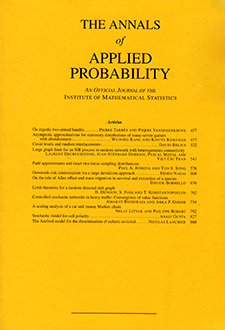Abstract
In recent years there has been a growing interest in the study of the dynamics of stochastic populations. A key question in population biology is to understand the conditions under which populations coexist or go extinct. Theoretical and empirical studies have shown that coexistence can be facilitated or negated by both biotic interactions and environmental fluctuations. We study the dynamics of $n$ populations that live in a stochastic environment and which can interact nonlinearly (through competition for resources, predator–prey behavior, etc.). Our models are described by $n$-dimensional Kolmogorov systems with white noise (stochastic differential equations—SDE). We give sharp conditions under which the populations converge exponentially fast to their unique stationary distribution as well as conditions under which some populations go extinct exponentially fast.
The analysis is done by a careful study of the properties of the invariant measures of the process that are supported on the boundary of the domain. To our knowledge this is one of the first general results describing the asymptotic behavior of stochastic Kolmogorov systems in non-compact domains.
We are able to fully describe the properties of many of the SDE that appear in the literature. In particular, we extend results on two dimensional Lotka-Volterra models, two dimensional predator–prey models, $n$ dimensional simple food chains, and two predator and one prey models. We also show how one can use our methods to classify the dynamics of any two-dimensional stochastic Kolmogorov system satisfying some mild assumptions.
Citation
Alexandru Hening. Dang H. Nguyen. "Coexistence and extinction for stochastic Kolmogorov systems." Ann. Appl. Probab. 28 (3) 1893 - 1942, June 2018. https://doi.org/10.1214/17-AAP1347
Information





